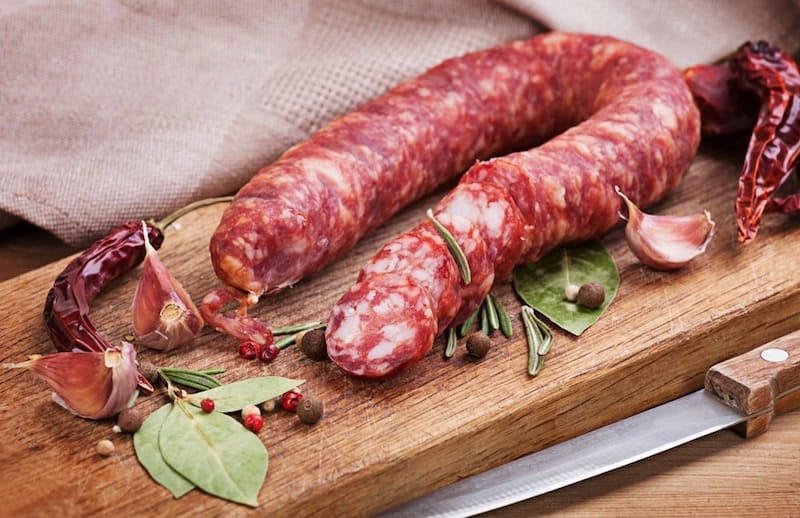Chorizo vs. Pepperoni (Similarities and Differences Explained)
Is there anything better than a pizza covered with hot red pepperoni? The spicy sausage is a signature American meat snack, perhaps rivaled only by the delicious chorizo.
The two sausages have a lot in common, especially in the meat and pepper-based aroma. However, the chorizo vs. pepperoni debate mostly boils down to seasoning—both are on the spicier side.
| Chorizo | Pepperoni | |
|---|---|---|
| Meat | Pork | Ground Pork or Beef |
| Spices and Herbs | Smoked Paprika, Chili Pepper, Garlic, Wine, Vinegar, Coriander, Cumin | Salt, Allspice, Red Pepper Powder, Sugar |
| Vitamins | Vitamin D, Vitamin B1, Vitamin B2, Vitamin B5, Vitamin B6, Vitamin B12 | Vitamin E, Vitamin K, Folate |
| Minerals | Iron, Potassium, Zinc | Calcium, Copper |
| Calories | 455 | 504 |
| Fats | 38.27 | 46.28 |
| Protein | 24.1 | 19.25 |
| Sodium | 1,235 | 1,582 |

What is Chorizo?
Chorizo refers to a type of fatty, spicy sausage made with pork and seasoned with smoked paprika or a different kind of pepper.
There are many different varieties, each determined by local ingredients and culinary traditions. Depending on the geographical and cultural region, chorizo can differ in name, preparation, and most importantly – flavor.
In the U.S., the two most widespread varieties are Spanish and Mexican chorizo. Both sausages are dark red in color, spicy, and made with pork (typically the shoulder).
The difference lies in the way the meat is processed and served. Mexican chorizo is sold fresh, so you have to cook it before having a bite. In contrast, Spanish chorizo is usually smoked or curated and thus a lot drier. The latter is much closer to pepperoni since we’re making the comparison.
Spanish chorizo is made from cured or semi-cured chopped pork (typically smoked) and is primarily flavored with smoky Spanish paprika.
Funnily enough, each province in Spain has its type of chorizo. The sausages come in all shapes and sizes. It can be softer or drier, spicier or sweeter, long and slim, or short and fat.
Mexican chorizo is made from fresh ground pork and is primarily flavored with chili peppers instead of smoked paprika. Sure, the hefty price of imported spices is part of the reason why, but there’s more to it than that. The Guajillo chili pepper is a staple of Mexican culinary culture and a vital ingredient of the chorizo.
Lastly, both varieties can be found in the cured meats department of most supermarkets. If you have a taste for artisan products, you can check out your local farmer’s market and look for traditionally made chorizo.

What is Pepperoni?
Ironically, the original Italian word refers to big bell peppers and has little to do with meat.
While there are similar spicy meat treats in the Apennine Peninsula, the pepperoni sausage is as American as apple pie.
Simply put, it’s a type of salami made with cured pork and beef, seasoned with paprika or other chili peppers. Pepperoni is distinguished by its smooth, mildly smoky texture and bright red hue.
Some varieties are made with turkey meat and chicken, although hardcore foodies will argue that compromises the authenticity.
Apart from the name, the tasty meat snack has no apparent relation to Italy besides being an Italian-American creation.
However, it’s worth noting that curing pork meat is a tradition that dates back to the Roman Empire. In the absence of refrigeration methods, the Romans were believed to have invented the practice of preserving their meats for lengthy periods.
Whether frozen or made from scratch, all types of pepperoni have their own set of ingredients that add a certain je ne sais quoi.
Some elements are considered standard, but the way they’re blended can significantly influence the aroma. In other words, the flavor is determined by the variety of spices and chilies included in the mix.
However, the typical spices usually include:
- Minced pork or beef
- Salt
- Insta Cure
- Red pepper powder
- Allspice
- Garlic
- A pinch of sugar
In the United States, pepperoni is almost synonymous with Hormel, the country’s most famous brand. Hormel Foods was founded in 1891 and has since won over the hearts of foodies across all 50 states.
The signature recipe includes medium-chopped beef seasoned with red pepper and several secret ingredients. It’s the most representative type of pepperoni, for sure.
Chorizo vs. Pepperoni: How are They Similar?
Apart from being the go-to meat snack of foodies worldwide, the two sausages share a few other similarities.
Mainly, both chorizo and pepperoni are made with pork and seasoned with some type of pepper, making them a spicy treat.
Spanish chorizo is probably the closest to the American sausage due to its texture. Since the meat is slow-cooked and subsequently smoked, the link is much drier than the Mexican chorizo.
As a result, you can slice it right off the bat and serve it as finger food.
The same goes for pepperoni, America’s favorite pizza topping. While you can cook or fry it, there’s no danger in eating it raw.
Chorizo vs. Pepperoni: How are They Different?
The most significant distinction between chorizo and pepperoni is probably the meat mixture and country of origin.
Chorizo is a type of cured and grilled pork sausage that originated in the Iberian Peninsula. It’s usually smoked or curated, except Mexican chorizo that’s sold fresh. Chorizo is typically a tad drier as well.
Pepperoni is a typical American sausage, most commonly used as a pizza topping. The sausage is made with a combination of ground meat or, to be exact, pork and beef. It doesn’t require any further preparation, so you can slice it up and start munching.
Both pepperoni and chorizo are cured pork products, but their fat content and nutritional values vary.
When the two meat snacks are compared, pepperoni has more saturated fats. In contrast, chorizo has more protein, carbs, water, and lower cholesterol. The overall calorie count is incredibly close, with pepperoni having a higher index value.
Chorizo is famously rich in minerals, including magnesium, potassium, and zinc. Compared to that, pepperoni is not as nutritious. However, the sodium content of chorizo is also somewhat lower, making it a slightly healthier snack in comparison.
The Spanish sausage contains slightly more vitamin B1 than pepperoni, making it an excellent food for those with a vitamin B deficiency. It also has much more vitamin D, especially the hand-crafted variety. Pepperoni, on the other hand, is richer in vitamin E, vitamin K, and folate.
In Summary
While you could say both chorizo and pepperoni are a type of spicy pork sausage, the similarities end there. The seasoning alone is quite different, not to mention the nutritional value of each meat product.
Interested in how other types of sausages compare to chorizo? Check out my other articles that compare chorizo to:







